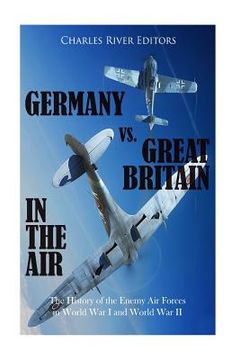Germany vs. Great Britain in the Air: The History of the Enemy Air Forces in World War I and World War II (en Inglés)
Reseña del libro "Germany vs. Great Britain in the Air: The History of the Enemy Air Forces in World War I and World War II (en Inglés)"
*Includes pictures *Includes accounts of fighting *Includes online resources and a bibliography for further reading One of the most important breakthroughs in military technology associated with World War I, and certainly the one that continues to capture the public imagination, was the use of airplanes, which were a virtual novelty a decade before. While the war quickly ground to a halt in its first few months, the skies above the Western Front became increasingly busy. The great powers had already been acquiring aircraft for potential uses, but given that aerial warfare had never been a major component of any conflict, it's understandable that few on either side had any idea what the planes were capable of doing. Furthermore, at the start of the war, all sides' aircraft were ill-equipped for combat mostly because the idea that planes might somehow fight was still a novel one, and the adaptations had not yet been developed that would allow the aerial battles later in the war. The Royal Air Force (RAF), Britain's legendary air arm, was born in the skies above the First World War. The British had previously used balloons for spotting and reconnaissance for decades, and in the years leading up to the war, planes started seeing military use. They mostly provided reconnaissance, though experiments were made in using them offensively. During the Boer War of 1899-1902, the British Army used the crews of helium-filled balloons to plot and help target artillery fire. But these were small, tentative steps. The first patent to fit a machine gun to a plane, taken out in 1910, had not yet led to active fighting vehicles, and there was no doctrine, no tactics, and no combat between massed air fleets. That changed during World War I, as the skies above the Western Front became the crucible in which the preceding fragments of aerial warfare were smelted in the white hot heat of war. For the British, this meant the creation of a large and unified flying force which by 1918 would become the RAF. The Third Reich's Luftwaffe began World War II with significant advantages over other European air forces, playing a critical role in the German war machine's swift, powerful advance. By war's end, however, the Luftwaffe had been decimated by combat losses and crippled by poor decisions at the highest levels of military decision-making, and it proved unable to challenge Allied air superiority despite a last-minute upsurge in German aircraft production. Though the superb fighting qualities of highly trained and motivated German soldiers, and the Third Reich's technological superiority in tank and weapon design, also had crucial roles to play, the Luftwaffe represented the key element making the successes of all other branches possible. While the Luftwaffe enjoyed air superiority, the combat fortunes of the Third Reich continued to ride high. When control of the air passed decisively to the Allies, Germany's hopes of victory began accelerating into a spiral of defeat. Much of it was due to the RAF and the Battle of Britain. The largest air campaign in history at the time, the vaunted Nazi Luftwaffe sought to smash the RAF as a prelude to German invasion, leaving the British public and its pilots engaged in what they believed was a desperate fight for national survival. That's what it looked like to the rest of the world too, as free men everywhere held their breaths. Could these pilots, many not yet old enough to shave, avoid the fate of Poland and France? The fate of the free world, at least as Europe knew it, hung in the balance over the skies of Britain during those tense months. Of course, the RAF was instrumental in other ways during the war. The RAF supported Allied forces all over the world, from Norway to Burma to Tunisia, and the RAF conducted devastating bombing campaigns against German industry and cities.

